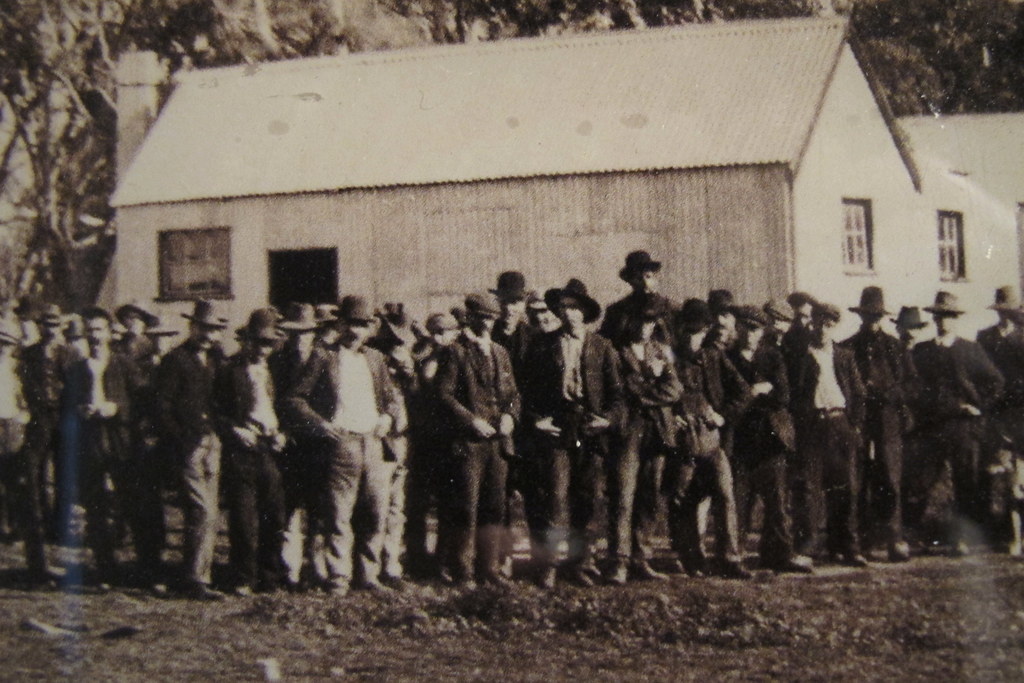Yanga Homestead was constructed between 1867 1872. The homestead kitchen wing appears to have been constructed in two stages with the southern half of the building possibly built around 1862. The southern half features walls of adzed drop slabs set between vertical posts while the northern side of the kitchen wing is of drop log construction (Cypress pine logs with adzed ends). This section contains a pantry, kitchen, maid's room, storage rooms and the station office.
The main homestead wing facing east is also of drop log construction but the logs have tenoned ends and painted uprights. A tenon is a projection on the end of a piece of wood shaped for insertion into a mortice to make a joint.
Local drop log construction used either logs cleaned of bark or with bark attached. Bark has been retained on the logs used at Yanga. Cypress logs have also been used to support veranda roofs and rafters.
The interior design comes from the wool boom of the 1950s, with little evidence surviving from earlier periods.
Pressed metal ceilings and door lintels in the formal dining room appear to date from the 1920s following acquisition of the property by Sims Cooper in 1919. The northern end of the homestead was converted into an apartment for the manager and his family in the 1980s.
YANGA COUNTRY
BEFORE ALL THE DAMS, WEIRS AND IRRIGATION appeared along the Murrumbidgee River, the so-called 'flooded country below Hay' was a landscape of stately River Red Gum forests and blue lakes. Travellers to this river country' have long noted how its shade, water and lush seasonal grasses sharply contrast with the surrounding dry, saltbush plains.
For thousands of years the low 'Bidgee regularly spilled its banks as it neared the Murray River, full of snow-melt and spring rains carried from distant mountain ranges. These floods created a place teeming with fish and migratory birds that was a valuable economic resource for Aboriginal people in the area. The Nari-Nari, Wadi-Wadi and Mutthi-Mutthi people fished, farmed and hunted in what was one of the most densely populated areas in the country.
Although the river country was boggy, wet and swampy, some Europeans also saw it as a valuable resource. From the 1840s squatters such as George Hobler arrived, looking for grasslands to run their sheep. Some were driven off by Aboriginal warriors. Others either forced their occupation through firearms, or like Hobler, offered Aboriginal people work on their squatting runs. Huge swathes of Aboriginal land were claimed by squatters - sometimes up to 500,000 acres. By the 1850s a series of runs had been converted to a leasehold of nearly 300,000 acres called Yanga Station. Yanga stretched from the Nap Nap swamps in the north to Yanga Lake in the south - over one hundred and fifty kilometres of 'Bidgee riverbank. Much of the land flooded annually, so the early pastoralists made sure they had some 'high ground' for their stock to shelter on. When the floods receded each year, not only were the lakes replenished, but good grazing grasslands appeared. During the 1850s Augustus Morris and his wife Eliza built a red gum slab homestead on the peninsular overlooking Yanga lake. Eliza set about establishing a garden that was to be a well-known feature of the Yanga homestead for the next 150 years.
The Morris' simple red gum building was enlarged to a grander residence during the mid-nineteenth century and the remarkable pine drop-log homestead became the centre of operations of the largest freehold title pastoral station in Australia.
HOMESTEAD GARDENS
Photographic evidence suggests that the current garden layout was developed a short time before 1920 and retained its general character throughout the twentieth century. Early photographs show a profusion of annuals planted in the garden beds and a formal garden had also been established in the courtyard formed by the two wings of the homestead. Much of this was removed when a tennis court was later constructed.
A terrace between the formal garden and the lake once contained a substantial vegetable garden which produced sufficient produce for the needs of the station and sale of surplus in Balranald. A small gardener's hut is located at the northern end of this terrace. An orchard is located to the north of the formal garden.
Where: 38773 Sturt Highway, Yanga, NSW, 2711 - in Yanga National Park
Accessibility: Easy
Price: $15 for an audio set if you'd like to take a self-guided tour.
Opening times: Yanga Homestead precinct is open 8.30am to 4.30pm daily.
What to bring: Drinking water
Bookings: Collect a self-guided tour package (key, audio and map) at the Yanga National Park office on site.
TEXT SOURCE: NSW Parks & Wildlife Service









1 comment:
Will Have 2 Come & have a Look i Have Number Plates on my Ute they are YANGA .
Post a Comment